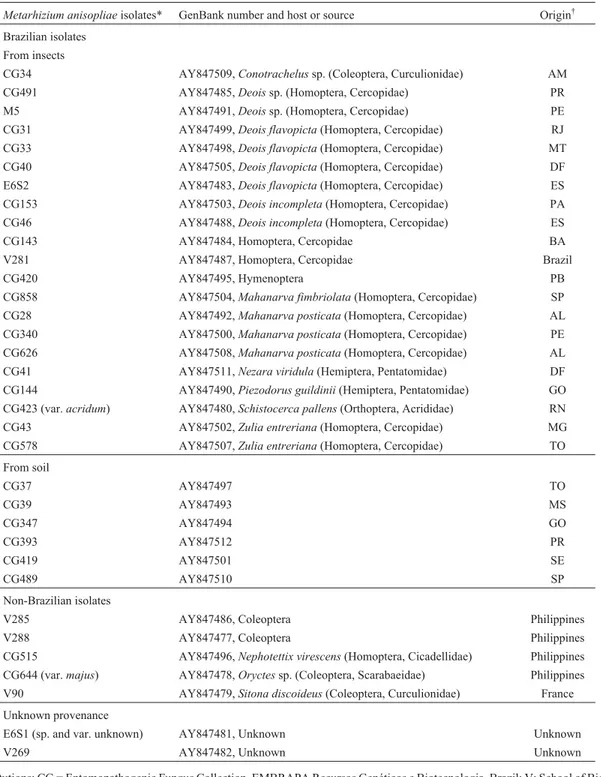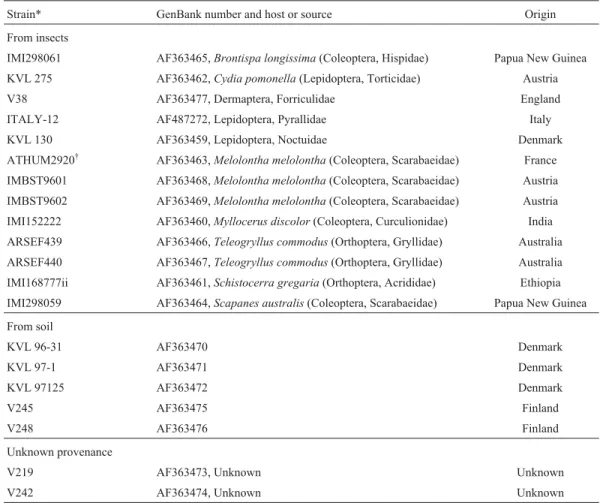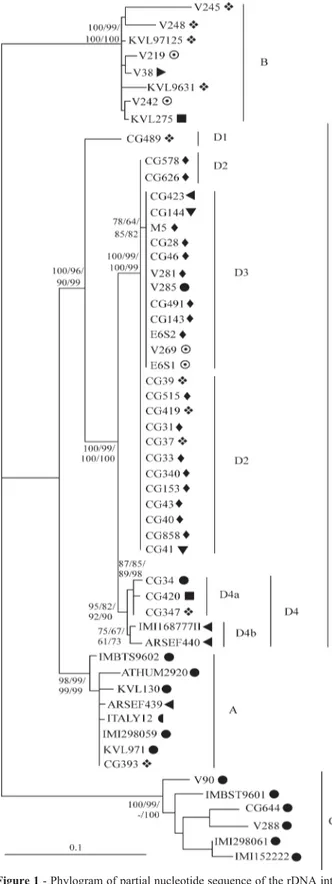Sequence analysis of the rDNA intergenic spacer of
Metarhizium
strains
isolated in Brazil
Fabiana Y. Yanaka-Schäfer
1, Leonara P. Dall’Onder
1, Mariana C. Panichi
1, Roberta G. Mendes
1,
Nelson J.R. Fagundes
1,2, Josiane B. Bandinelli
1and Maurício R. Bogo
11
Laboratório de Biologia Genômica e Molecular, Faculdade de Biociências,
Pontifícia Universidade Católica do Rio Grande do Sul, Porto Alegre, RS, Brazil.
2
Departamento de Genética, Instituto de Biociências, Universidade Federal do Rio Grande do Sul,
Porto Alegre, RS, Brazil.
Abstract
To assess the extent of genetic variability of rDNA intergenic spacer (IGS) inMetarhizium sp., 34 strains (27 isolated in Brazil) were sequenced and analyzed together with an additional 20Metarhizium anisopliae var. anisopliae se-quences retrieved from GenBank. Overall, the global nucleotide diversity for the region under study was of 0.090, while for the Brazilian isolates it was only 0.016. Phylogenetic analyses showed four well-supported groups (A, B, C, and D), one of which (D) has not been previously identified. All but one of the Brazilian strains cluster in this novel D phylogroup, suggesting that the genetic variation found in Brazil is a subset of the worldwideM. anisopiliae var. anisopliae variation.
Key words:intergenic spacer,Metarhizium, rDNA.
Received: April 5, 2007; Accepted: July 24, 2007.
The entomopathogenic fungus Metarhizium anisopliae (Metschnikoff) Sorokin (Deuteromycotina, Hyphomycetes) is an “obligate killer” (Ebert and Weisser, 1997) which has consequently been much studied for po-tential use as a biological control agent of insect pests in many countries. The utilization and the improvement of mycoinsecticides could be an alternative tool to overcome the considerable environmental impact and high economi-cal costs posed by conventional insecticides (Roberts and St. Leger, 2004). The non-transcribed intergenic region (IGS) and the internal transcribed spacers (ITS) located in the nuclear ribosomal DNA (rDNA) gene cluster evolve rapidly and have been widely used as a tool to evaluate the genetic diversity within populations of fungi (Mavridou and Typas, 1998; Pantouet al., 2003; Hugheset al., 2004; Velásquezet al., 2007) and to resolve problems regarding the identification of species and isolates based on morpho-logical characters (Milneret al., 1994; Driveret al., 2000; Iwenet al., 2002).
Even thoughMetarhiziumstrains have been used in Brazil against a number of insect pests since the 1980s
(Garciaet al., 1984), an evaluation on the intraspecific ge-netic variability ofMetarhiziumisolates from Brazil has not so far been performed. Since better characterization of the genetic variation within an entomopathogenic fungus population could be useful for the selection of more effi-cient isolates for biological control, the aim of this study was to assess the extent of genetic variability in the IGS re-gion ofMetarhiziumstrains with special attention placed on the Brazilian isolates.
The 34Metarhiziumsp. isolates (27 isolated in Bra-zil) that were used in this study (Table 1) were provided by the following organizations: Brazilian Agricultural Re-search Corporation (Empresa Brasileira de Pesquisa Agro-pecuária-Embrapa) Genetics and Biotechnology Research unit (Centro Nacional de Pesquisa de Recursos Genéticos e Biotecnologia - CENARGEN), Brasilia-DF, Brazil; School of Biological Sciences, University of Wales, University College Swansea, Swansea, Wales, UK; and Escola Supe-rior de Agricultura Luiz de Queiroz (ESALQ) Brazil. The Isolates were cultivated in liquid complete Cove’s medium (CCM) at 28 °C for 7 days and DNA was extracted and pu-rified according to Raeder and Broda (1985). The IGS re-gion of 34 Metarhizium strains was amplified using the Ma-28S4 and Ma-IGS1 primer set designed for amplifica-tion ofM. anisopliaevar.anisopliaerDNA (Pantouet al., 2003). The PCR reactions contained 0.2 mM of dNTP,
www.sbg.org.br
Send correspondence to Maurício Reis Bogo. Faculdade de Bio-ciências, Pontifícia Universidade Católica do Rio Grande do Sul, Av. Ipiranga 6681, Prédio 12C, Sala 172, 90619-900 Porto Alegre, RS, Brazil. E-mail: mbogo@pucrs.br.
0.4µM of each primer, 10 mM Tris-HCl, pH 8.0, 50 mM KCl, 0.5 units of Taq DNA Polymerase (Invitrogen) and 2.0 mM of MgCl2. Amplification used an initial denaturing
step at 95 °C for 3 min followed by 30 cycles at 95 °C for 1 min, 50 °C for 1 min and 72 °C for 1 min 30 s, followed by
a final extension step at 72 °C for 10 min. The PCR prod-ucts were purified with exonuclease I and shrimp alkaline phosphatase (GE Healthcare). The sequencing reactions were performed using the DYEnamic ET Dye Terminator Kit (GE Healthcare) and were read in a MegaBACE 1000
Table 1- TheMetarhizium anisopliaeisolates characterized in this study, their hosts and geographic origins. Except where indicated all isolates were
Metarhizium anisopliaevar.anisopliae.
Metarhizium anisopliaeisolates* GenBank number and host or source Origin†
Brazilian isolates
From insects
CG34 AY847509,Conotrachelussp. (Coleoptera, Curculionidae) AM
CG491 AY847485,Deoissp. (Homoptera, Cercopidae) PR
M5 AY847491,Deoissp. (Homoptera, Cercopidae) PE
CG31 AY847499,Deois flavopicta(Homoptera, Cercopidae) RJ
CG33 AY847498,Deois flavopicta(Homoptera, Cercopidae) MT
CG40 AY847505,Deois flavopicta(Homoptera, Cercopidae) DF
E6S2 AY847483,Deois flavopicta(Homoptera, Cercopidae) ES
CG153 AY847503,Deois incompleta(Homoptera, Cercopidae) PA
CG46 AY847488,Deois incompleta(Homoptera, Cercopidae) ES
CG143 AY847484, Homoptera, Cercopidae BA
V281 AY847487, Homoptera, Cercopidae Brazil
CG420 AY847495, Hymenoptera PB
CG858 AY847504,Mahanarva fimbriolata(Homoptera, Cercopidae) SP
CG28 AY847492,Mahanarva posticata(Homoptera, Cercopidae) AL
CG340 AY847500,Mahanarva posticata(Homoptera, Cercopidae) PE
CG626 AY847508,Mahanarva posticata(Homoptera, Cercopidae) AL
CG41 AY847511,Nezara viridula(Hemiptera, Pentatomidae) DF
CG144 AY847490,Piezodorus guildinii(Hemiptera, Pentatomidae) GO
CG423 (var.acridum) AY847480,Schistocerca pallens(Orthoptera, Acrididae) RN
CG43 AY847502,Zulia entreriana(Homoptera, Cercopidae) MG
CG578 AY847507,Zulia entreriana(Homoptera, Cercopidae) TO
From soil
CG37 AY847497 TO
CG39 AY847493 MS
CG347 AY847494 GO
CG393 AY847512 PR
CG419 AY847501 SE
CG489 AY847510 SP
Non-Brazilian isolates
V285 AY847486, Coleoptera Philippines
V288 AY847477, Coleoptera Philippines
CG515 AY847496,Nephotettix virescens(Homoptera, Cicadellidae) Philippines
CG644 (var.majus) AY847478,Oryctessp. (Coleoptera, Scarabaeidae) Philippines
V90 AY847479,Sitona discoideus(Coleoptera, Curculionidae) France
Unknown provenance
E6S1 (sp. and var. unknown) AY847481, Unknown Unknown
V269 AY847482, Unknown Unknown
*Source institutions: CG = Entomopathogenic Fungus Collection, EMBRAPA Recursos Genéticos e Biotecnologia, Brazil; V: School of Biological Sci-ences, Swansea, UK (Dr. Butt); strains E6S1, E6S2 and M5 were obtained from Escola Superior de Agricultura Luiz de Queiroz (ESALQ) Brazil. †Brazilian state codes: AL, Alagoas; AM, Amazonas state; BA, Bahia; DF, Distrito Federal; ES, Espírito Santo; GO, Goiás; MT, Mato Grosso; MS, Mato
sequencer (GE Healthcare). After checking the chroma-tograms using the Chromas 2.23 program the DNA se-quences were preliminarily aligned with ClustalX (Thompsonet al., 1997) and edited by visual inspection with the BioEdit program. An additional 20 strains ofM. anisopliaevar. anisopliaewere retrieved from GenBank using BLAST (Table 2) and were also included in the anal-ysis.
We selected the best evolutionary model in the Mo-deltest 3.06 program (Posada and Crandall, 1998), in which the K2P+G model (Kimura-2-Parameter with Gamma cor-rection) received greatest support. Phylogenetic analysis using Neighbor-Joining (NJ) was performed with Mega 2.1 (Kumaret al., 2001) based on K2P+G distance. To deter-mine the reliability of the observed groups, 1000 bootstrap replicates were performed. Maximum Parsimony (MP) trees were constructed in PAUP* 4.0 (Swofford, 2002) us-ing ten replicates of heuristic searches with random addi-tion of sequences, and branch support was evaluated with
100 bootstrap replicates. Maximum likelihood (ML) trees were generated with PHYML (Guindon and Gascuel, 2003), based on a NJ starting tree and using the K2P+G model with parameters estimated during tree search. The BOOTPHYML program was used to perform 200 boot-strap replicates. Finally, Bayesian Inference (BI) was car-ried out using MRBAYES (Ronquist and Huelsenbeck, 2003) under K2P+G using 1,000,000 MCMC steps and sampling every 100 steps. The chains became stationary af-ter 40,000 steps, so previous steps were discarded as burn-in. The estimation of the tree with the highest posterior probability was done through the majority-rule consensus of the remaining 9,700 trees. For each clade, nucleotide di-versity (p) and its standard error were calculated using Mega 2.1 (Kumaret al., 2001).
The amplicons generated fromMetarhiziumisolates using the Ma-28S4 and Ma-IGS1 primers resulted in se-quences of about 800 bp. The variability in length of IGS amplicons observed among the isolates sampled in this
Table 2- The rDNA intergenic spacer rDNA sequences ofMetarhizium anisopliaevar.anisopliaeisolates retrieved from GenBank, with their hosts and geographic origins.
Strain* GenBank number and host or source Origin
From insects
IMI298061 AF363465,Brontispa longissima(Coleoptera, Hispidae) Papua New Guinea
KVL 275 AF363462,Cydia pomonella(Lepidoptera, Torticidae) Austria
V38 AF363477, Dermaptera, Forriculidae England
ITALY-12 AF487272, Lepidoptera, Pyrallidae Italy
KVL 130 AF363459, Lepidoptera, Noctuidae Denmark
ATHUM2920† AF363463,Melolontha melolontha(Coleoptera, Scarabaeidae) France
IMBST9601 AF363468,Melolontha melolontha(Coleoptera, Scarabaeidae) Austria
IMBST9602 AF363469,Melolontha melolontha(Coleoptera, Scarabaeidae) Austria
IMI152222 AF363460,Myllocerus discolor(Coleoptera, Curculionidae) India
ARSEF439 AF363466,Teleogryllus commodus(Orthoptera, Gryllidae) Australia
ARSEF440 AF363467,Teleogryllus commodus(Orthoptera, Gryllidae) Australia
IMI168777ii AF363461,Schistocerra gregaria(Orthoptera, Acrididae) Ethiopia
IMI298059 AF363464,Scapanes australis(Coleoptera, Scarabaeidae) Papua New Guinea
From soil
KVL 96-31 AF363470 Denmark
KVL 97-1 AF363471 Denmark
KVL 97125 AF363472 Denmark
V245 AF363475 Finland
V248 AF363476 Finland
Unknown provenance
V219 AF363473, Unknown Unknown
V242 AF363474, Unknown Unknown
*Source institutions: ATHUM = University of Athens Fungal Collection, Athens Greece; ARSEF = US Department of Agriculture, Agriculture Research Service Entomopathogenic Fungus Collection, USDA-ARS; IMBST = Institut für Mikrobiologie, Leopold-Franzens Universität, Innsbruck, Austria; IMI = International Mycological Institute, Egham, UK; ITALY = L. Rovesti, Centro di studio dei Fitopharmaci, Bologna, Italy; KVL = Royal Veterinary and Agricultural University, Frederiksberg, Denmark; V = School of Biological Sciences, Swansea, UK (Dr. Butt).
study has also been observed in other studies with
Metarhiziumstrains (Mavridou and Typas, 1998; Pantouet al., 2003) and other fungi in the Hypocreales (Mishraet al., 2002). Including all insertion sites, we obtained a final aligned data set of 983 bp. Insertion/deletion events were treated as missing data and therefore the phylogenetic anal-yses were performed based on 512 bp. The final alignment of the IGS sequences showed high nucleotide diversity among isolates (π= 0.090±0.007).
Because all methods resulted in trees with similar to-pologies, we only show the ML tree with the branch support values obtained from all methods (Figure 1). All methods showed the formation of four well-supported groups (A, B, C and D). Groups A, B and C were reported (with identical names) in other studies (Hugheset al., 2004; Pantouet al., 2003) and Hughes et al. (2004) also demonstrated that group A was subdivided in three subgroups (A1, A2 and A3). Our results support the existence of groups A, B and C, with the addition of a novel group (D), all with very high support values.
Group A showed a nucleotide diversity of 0.010±0.002 and was composed of isolates IMBST9602, ATHUM 2920, KVL130, ARSEF439, ITALY12, IMI298059, KVL971 and CG393. In spite of all isolates beingM. anisopliaevar.anisopliae, they were from hosts belonging to different insect orders and from different geo-graphic origins. Group A also contained the only Brazilian isolate that did not cluster in group D (CG393).
Group B isolates had a nucleotide diversity of 0.027± 0.004, shared a deletion at position 729-732 and clustered withM. anisopliaevar.anisopliaeisolates from European climates and collected from either insects or soil. Isolates V245, V218, KVL97125 and KVL9631 were from soil. Strains V219 and V242 were isolated from unknown hosts, but grouped consistently with isolates whose hosts belonged to the orders Dermaptera and Lepidoptera respec-tively. Although this could be an indication that these iso-lates came from insects, it is not possible to be very certain given that the sample size for this group was not large.
Group C was exclusively formed by isolates from Coleopteran hosts and was the group with the largest nucle-otide diversity (π= 0.054±0.006). This group was charac-terized by the presence of three deletions (positions 217-229, 262-337 and 663-666) plus the 729 to 732 dele-tion also observed in Group B, and is the same grouping ob-served by Hugheset al.(2004) and Pantou et al.(2003) with the addition of isolates V90, CG644 and V288 from our study. Isolates CG644 and V288 were previously clas-sified asM. anisopliaevar.majus, but grouped consistently with other isolates classified as var.anisopliae. Given the difficulties that can arise from a morphology based classifi-cation (Milneret al., 1994) we think that the more likely explanation is that these isolates were previously misidenti-fied. Alternative explanations would imply that the M. anisopliaevar.anisopliaeisolates in this group were
identified or that IGS does not have enough power to dis-criminate between these varieties.
Group D, previously unidentified, included all but one of the Brazilian isolates together with other tropical isolates from Papua New Guinea, the Philippines, Australia and Ethiopia. This group had a nucleotide diversity of π= 0.012±0.002 and was divided into four subgroups D1, D2, D3 and D4, with subgroup D4 being further subdivided into D4a and D4b. Subgroup D1 contained only isolate CG489, which also presented one exclusive deletion (posi-tion 281-302). Some discrepancies about morphological and genetic species classification were found in subgroups D2 and D3. Our study strongly suggests that isolates CG423 (M. anisopliaevar.acridum), V285 (M. anisopliae
var. majus) and CG515 (M. album) are in fact all M. anisopliaevar. anisopliae. This result was in agreement with former studies that demonstrated the lack of accuracy of morphological classification (Driveret al., 2000). Iso-lates from subgroup D4a shared a common deletion at 379-564 bp, while isolates of D4b group had one deletion at 92-125 bp. Interestingly, isolates from group D4b were both isolated from an Orthoptera host, even though in dif-ferent continents. On the other hand, isolates in group D4a were all from the same country but each one isolated from hosts belonging to different Insect orders.
Overall, the nucleotide diversity in the Brazilian iso-lates was 0.016±0.002, considerably lower than the esti-mate of 0.124±0.008 obtained when excluding the Brazil-ian isolates. Together with the finding that all but one of the Brazilian isolates belongs to Group D, this suggests that the genetic diversity ofM. anisopliaevar.anisopliaefound in Brazil represents only a subset of the worldwide diversity within this variety.
Our results suggest that the IGS region can easily as-signM. anisopliaevar.anisopliaeisolates to one of the ex-isting clades, and that it may help to solve discrepancies in the current classification of these isolates, even though the number of strains with identical genetic profiles (Figure 1) suggests that it is not well suited for individual isolate iden-tification. While to some extent it was possible to associate phylogenetic position of the isolates with the hosts from which they were isolated or to the climatic zone of origin, on a finer scale a strong association between genetic and host or geographic origin was not found. Finally, we ob-served that although almost all Brazilian isolates can be as-signed to Group D there is some genetic diversity among Brazilian strains, even among samples isolated in the same Brazilian region.
Acknowledgments
The authors thank the Brazilian state agency Funda-ção de Amparo à Pesquisa do Estado do Rio Grande do Sul (FAPERGS) for financial support and Brazilian Agricul-tural Research Corporation (Empresa Brasileira de
Pesqui-sa Agropecuária - Embrapa) for providing the Brazilian strains. MCP was a recipient of a FAPERGS fellowship. RGM was a recipient of fellowship from the Catholic Uni-versity Rio Grande do Sul (Pontifícia Universidade Cató-lica do Rio Grande do Sul - BPA/PUCRS). The authors thank Dr. Soraya C.M. Leal-Bertioli for some DNA strains used in this work and Dr. Eduardo Eizirik for a critical read-ing of the manuscript. We also thank Cladinara R. Sarturi for technical laboratory assistance and Felipe G. Grazziotin for helpful discussion regarding the phylogenetic analysis.
References
Driver F, Milner RJ and Trueman WH (2000) A taxonomic revi-sion of Metarhiziumbased on a phylogenetic analysis of rDNA sequence data. Mycol Res 104:134-150.
Ebert D and Weisser WW (1997) Optimal killing for obligate kill-ers: The evolution of life histories and virulence of seme-lparous parasites. Proc R Soc Lond 264:985-991.
Garcia AS, Messias CL, Souza HML and Piedrabuena AE (1984) Patogenicidade deMetarhizium anisopliaevar.anisopliae
em Ceratitis capitata(Wied.) (Diptera, Tephritidae). Rev Bras Entomol 28:421-424.
Guindon S and Gascuel O (2003) A simple, fast, and accurate al-gorithm to estimate large phylogenies by Maximum Likeli-hood. Syst Biol 52:696-704.
Hughes WOH, Thomsen L, Eilenberg J and Boomsma JJ (2004) Diversity of entomopathogenic fungi near leaf-cuting and nests in a neotropical forest, with particular reference to
Metarhizium anisopliaevar.anisopliae. J Invertebr Pathol 85:46-53.
Iwen PC, Hinrichs SH and Rupp ME (2002) Utilization of the in-ternal transcrib 17ed spacer regions as molecular targets to detect and identify human fungal pathogens. Med Mycol 40:87-109.
Kumar S, Tamura K, Jakobsen IB and Nei M (2001) MEGA2: Molecular Evolutionary Genetics Analysis software. Bio-informatics 17:1244-1245.
Velásquez VB, Cárcamo MP, Meriño CR, Iglesias AF and Durán JF (2007) Intraspecific differentiation of Chilean isolates of the enthomopathogenic fungiMetarhizium anisopliaevar.
anisopliaeas revealed by RAPD, SSR and ITS markers. Gen Mol Biol 30:89-99.
Mavridou A and Typas MA (1998) Intraspecific polymorphism in
Metarhizium anisopliaevar.anisopliaereveled by analysis of rRNA gene complex amd mtDNA RFLPs. Mycol Res 102:1233-1241.
Milner RJ, Driver F, Curran J, Glare TR, Prior C, Bridge PD and Zimmermann G (1994) Recent problems with the taxonomy of the genusMetarhizium, and a possible solution. Proceed-ings of the VIth International Colloquium of Invertebrate Pathology and Microbial Control. Montpellier, pp 101-116. Mishra PK, Fox RTV and Culham A (2002) Restriction analysis
of PCR amplified nrDNA regions revealed intraspecific variation within populations of Fusarium culmorum. Microbiol Lett 215:291-296.
Excellent tools for isolate detection and phylogenetic analy-sis. Fungal Genet Biol 38:159-174.
Posada D and Crandall KA (1998) Modeltest: Testing the model of DNA substitution. Bioinformatics 14:817-818.
Raeder U and Broda P (1985) Rapid preparation of DNA from fil-amentous fungi. Lett Appl Microbiol 1:17-20.
Roberts DW and St Leger RJ (2004)Metarhiziumspp., cosmopol-itan insect-pathogenic fungi: Mycological aspects. Adv Appl Microbiol 54:1-70.
Ronquist F and Huelsenbeck JP (2003) MrBayes 3: Bayesian phylogenetic inference under mixed models. Bioinformatics 19:1572-1574.
Swofford DL (2002) PAUP*: Phylogenetic Analysis Using Parsi-mony (and Other Methods) 4.0 Beta, Florida State Univer-sity. CD-ROM.
Thompson JD, Gibson TJ, Plewniak F, Jeanmougin F and Higgins DG (1997) The ClustalX windows interface: Flexible strate-gies for multiple seqeunce alignment aided by quality analy-sis tools. Nuc Acids Res 24:4876-4882.
Internet Resources
Chromas 2.23 at http://www.technelysium.com.au/chromas.html. BioEdit program at http://www.mbio.ncsu.edu/BioEdit/bioedit.
html.


